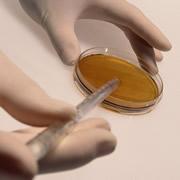 The field of therapeutic cloning has suffered a blow with revelations of fabricated data.© Photodisk
The field of therapeutic cloning has suffered a blow with revelations of fabricated data.© PhotodiskA rapid investigation of stem-cell researcher Woo Suk Hwang's work at Seoul National University has delivered a damning initial verdict: large amounts of the data in his 2005 landmark paper on patient-specific stem cells were fabricated.
Further investigation is expected to reveal whether any of the patient-specific stem-cell lines that Hwang claimed to have created are in fact what they purported to be1. The university is also investigating an earlier paper, published in Science2, in which Hwang reported the first success at producing stem cells from a cloned human embryo, and a later paper, published in Nature, in which he reported the first cloning of a dog (see ""Snuppy rewards dogged approach":http://www.nature.com/news/2005/050801/full/050801-7.html").
The university's investigating team convened on 15 December 2005. On 23 December it announced in a televised press conference that the data in the 2005 Science paper came from just two cell lines, not 11 as claimed. This "cannot be some error from a simple mistake, but can only be seen as a deliberate fabrication", the panel said.
"In this regard, Professor Hwang's Science paper violates the most fundamental ethics of scientific research," says a press release provided by Jung Hye Roe, chief of Seoul National University's research office.
In the case of the 9 cell lines for which evidence was lacking, DNA fingerprint tests purportedly matching the lines to specific patients were found to be worthless. DNA tests are now being carried out under the remit of the university investigation to see whether the two remaining cell lines are in fact cloned from specific patients, as claimed in the paper. The committee says these results should be back in a few days.
Roe told the news conference that "there is no way but that Professor Hwang has been involved", although the extent of his involvement in the deception remains unclear. Hwang has tendered his resignation to the university. But he insists that the two frozen stem-cell lines will prove to be valid. "I'd like to repeat: patient-tailored embryonic stem cells are South Korean technology," he told the press, and said that this would be confirmed. Hwang has said this since his work was first questioned in November (see ""Timeline of a controversy":http://www.nature.com/news/2005/051219/full/051219-3.html").
Names on the papers
It is also unclear whether and to what extent Hwang's co-authors knew about or were involved in any scientific deception. There are 25 authors on the 2005 paper, and 15 authors on a 2004 Science stem-cell paper led by Hwang; a total of 32 different people in all.
One of Hwang's co-authors on the 2004 Science paper is Ky Young Park, a plant scientist and presidential adviser for science and technology. Park wrote to Nature on 20 December that the President's Office will issue a comprehensive official statement about the controversy once the SNU investigation is over. The South Korean government has pumped billions of dollars into Hwang's research.
Two high-profile co-authors on the 2005 paper, Gerald Schatten of the University of Pittsburgh, Pennsylvania, and fertility specialist Sung Il Roh of MizMedi Hospital in Seoul, have recently tried to distance themselves professionally from Hwang. Co-author Curie Ahn, a Seoul National University transplantation expert who had acted as spokeswoman for the group over the past months, told Nature on 21 December that she was not involved in the generation of cells but only the clinical work. "I wish this message would straighten out any misunderstandings you may have on the role of each collaborator," wrote Ahn.
Blow to research
Of the 11 stem-cell lines purportedly presented in the 2005 Science paper, the investigators found that four had died after contamination with fungus in January 2005, and so could not be investigated. In the case of two further lines, there was no record at all. Three other cell lines had not been confirmed as stem cells when the paper was submitted to Science. Whether these latter three were stem cells or not, the data must have been altered for publication.
If it turns out that the stem-cell lines are not cloned from matched patients, it will prove a huge blow to the stem-cell community. No other research team has been able to prove that it is possible to create embryonic stem cells matched to individual patients. Such an achievement would pave the way to the production of replacement cells and tissues - a technique called therapeutic cloning. Hwang's fraud has had a predictably devastating impact on the field (see ""Where now for stem cells cloners?":/news/2005/051219/full/4381058a.html").
The officials have not said when their investigation will be end, or how much further its remit may expand. Both Nature and Science are conducting their own inquiries into the papers Hwang published with them. Korean prosecutors have also said they will investigate.
Commenting on the announcement, Jack Price, a developmental neurobiologist at the Institute of Psychiatry in London, said: "I guess we should have been suspicious given the speed with which he overcame problems that were holding back other labs. I guess in the end the pressure to succeed was too great. So much had been invested in him by the state. This is a spectacular collapse."
The coming weeks should show how much of the world's therapeutic cloning research, the status of South Korean research and trust in peer-reviewed journals the collapse will take with it.
